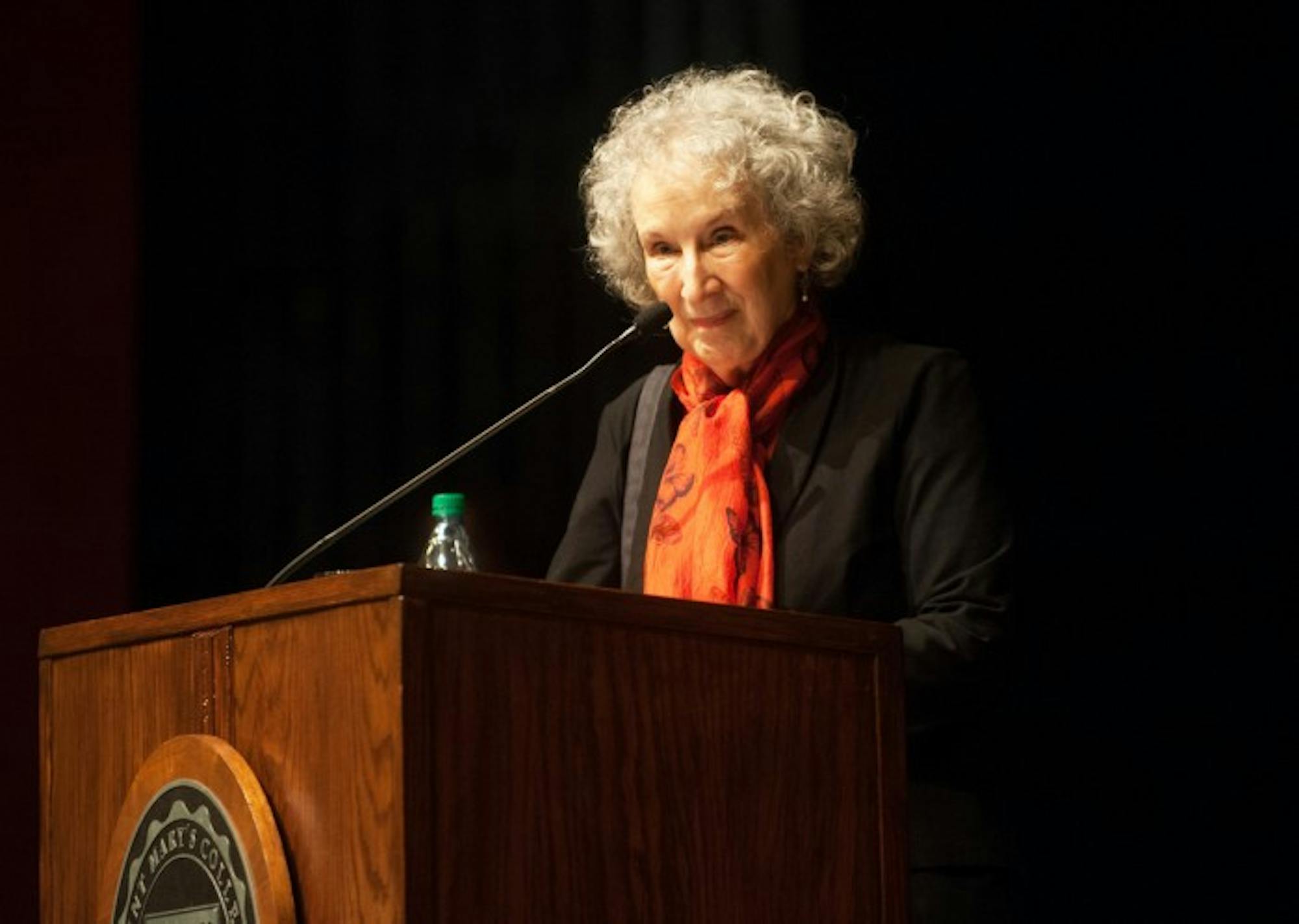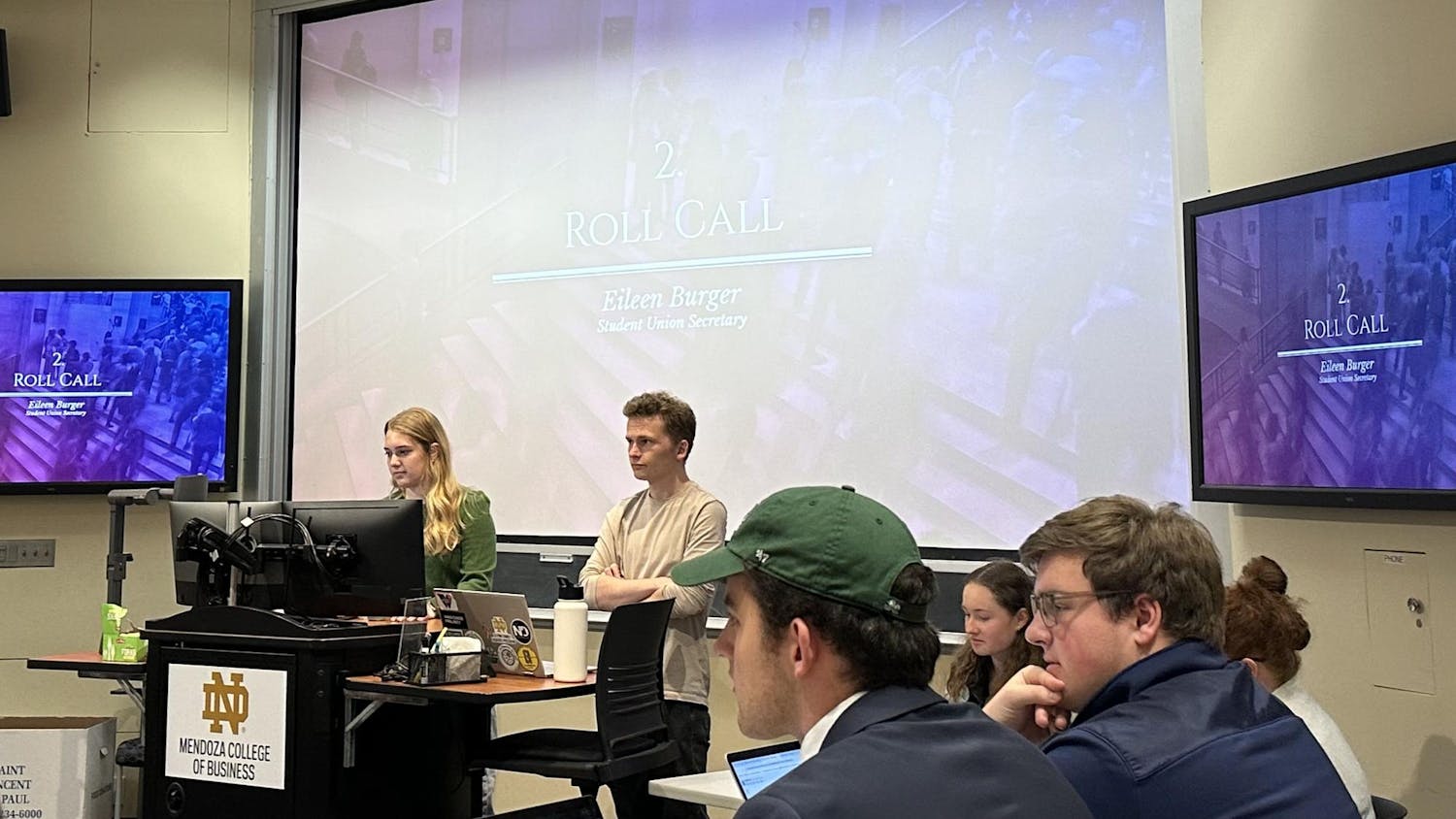With a Vera Wang clothing line honoring its characters and a Hulu original series adapting its plot, “The Handmaid’s Tale” has flooded modern society, but its author, Margaret Atwood, traced her work back to its sources during Saint Mary’s annual Christian Culture Lecture, which took place in O’Laughlin Auditorium on Wednesday.
College President Jan Cervelli said Atwood’s work causes readers to question societal norms and leads to new avenues of understanding.
“Perhaps most significantly to us at Saint Mary’s, Margaret Atwood is a woman who breaks open the limits society imposes on her,” Cervelli said. “She shines a sometimes uncomfortable light on those artificial boundaries in unflinching work that forces us to reconsider the world around us, and that serves as an inspiration to raise our own voices against the injustices we see.”
Atwood’s writing especially resonates at an all-women’s institution, where the plights of underrepresented groups often inform the curriculum, Cervelli said.
“She discovers a fearless social conscience, a mirror held up to show us the power structure we have built in an imaginative spark to broaden our conception of who we are and what we can be,” she said.
Interest in her work has endured over time and enforced the evergreen theme of society’s susceptibility to hierarchal regression, Atwood said.
“‘The Handmaid’s Tale,’ published in 1985-6 — before there was an internet, before there were cell phones, before there were even lattes, or at least before lattes were deployed as the stealth weapon from Europe to the extent that the are now — this novel, which by now ought to have become quaint and archaic, has become more believable over time, not less,” she said. “The iconic red and white outfit is now an internationally understandable meme popping up in state legislatures and cosplay conventions alike.”
The inspiration for her work, she said, involves distinct life experiences, such as the exploration of various forms of worship she underwent as a young woman.
“I was curious about religions and went about attending the services of as many religions as I could find in the Toronto of those days,” she said. “Each one of them was good at something, but the things they were good at were not the same. … My conclusion: No one group has got it all.”
Atwood said this openness to exploring the practices of multiple denominations ultimately contributed to her status as an agnostic.
“Should I, a quasi-martian join one of them?” she said. “Most likely not. Not only would I be ... disruptive ... as I would ask too many questions, but … I wouldn’t want to belong to a church that would have me for a member.”
Observing the prominent role religion plays in the development and evolution of culture, she said, constitutes an inevitable and necessary task for writers.
“Despite what I said about martians and agnostics, I am, of course, deeply immersed in Christian culture, both through … my upbringing … and through the present day world of North America, in which religion has gotten into politics in a major way and cannot, therefore, be discounted,” Atwood said.
A class she took during graduate school at Harvard University, she said, informed her of the Puritan theocracy of New England and accounts of the Salem Witch Trials, which she called “a rigged game, if ever there was one.”
“The man who taught this course was Perry Miller, who almost single-handedly brought the study of 17th century Puritan New England into the academy,” she said. “That was a very important thing to do since this theocracy is one of the foundation stones of the America we know today. That is why I dedicated ‘The Handmaid’s Tale’ to Perry Miller. He didn’t live to see it, but he would have understood exactly what I meant.”
Dilemmas and crises that have afflicted vulnerable populations around the world also compelled her to write “The Handmaid’s Tale,” Atwood said.
“The other sources are taken from human history, for my main goal for this book was that I would put nothing into it that had not been done by human beings at some time in some place,” Atwood said. “There is nothing in the book that is beyond our capabilities.”
Atwood said the novel exemplifies or warns against the ways in which multiple belief systems could be diminished.
“The regime is extinguishing any other religions, which is what totalitarian-isms do first,” she said. “They get rid of the closest rivals, and then they finish off everybody else.”
Current events and senseless violence not only influence her storytelling process but also cause her to ponder the effect individuals can have on the world, depending on their tendencies toward virtue or vice, she said.
“The human imagination is a wonderful thing when its goals are positive and a terrible thing when applied to malignant ends,” she said. “Weapons of mass destruction do not grow on trees. They exist because we invent them.”
Atwood said if she were to rewrite “The Handmaid’s Tale” today, she would incorporate some of the modern technological advancements that have taken place since its original composition.
“I would do a number of material things differently because we’re now living in a world that contains inventions that weren’t there in [1985], so I’d have to update that,” Atwood said. “I would have my regime seize control of the internet, which is what totalitarianisms try to do. … They would have to do something about cell phones and who was allowed to have them.”
The characters and events about which she writes, she said, often help develop the overarching message of her works.
“My books are not illustrated propaganda points,” she said. "I don’t start with the idea, like war is hell or love is nice. I don’t think that’s how books happen, though it’s often how they are taught.”
Atwood said she prefers to discover the didactic purpose or meaning of her writing as she integrates various perspectives and nuances her plot.
“When I’m working with a book, I’m working with the text, the sentences, the characters, what happens next, all of those kinds of things,” Atwood said. “The shall-we-say teachable theme emerges out of that sooner or later, but I don’t necessarily know what it is at the beginning.”













